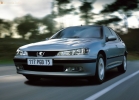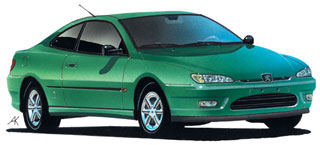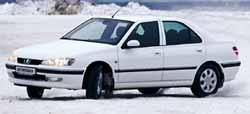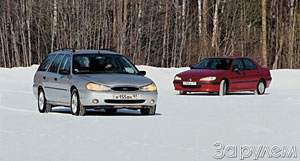PEUGEOT 406 1999 test drive - 2004 sedan
Smile!
 The continuity of generations is good. But not always, because it puts automakers in a certain framework. Whatever the beautiful Peugeot 406, nevertheless, it was necessary to bring it into line with the prevailing corporate image. The result was excellent. And how are things with continuity to the rest?
The continuity of generations is good. But not always, because it puts automakers in a certain framework. Whatever the beautiful Peugeot 406, nevertheless, it was necessary to bring it into line with the prevailing corporate image. The result was excellent. And how are things with continuity to the rest? When it comes to changing generations of a car, two concepts are used: evolution and revolution. Most often, these processes alternate. Here was a stylish car Peugeot 405, in the next generation a larger and solid 406th replaced it in the next generation. But stylistic changes were evolutionary. And 2004 was marked by the coup: PEUGEOT 407 appeared. Surprisingly, the middle class PEUGEOT was the last in the model range of the company to surgery in order to bring it into line with the branded style, the ancestor of which was the 206th. Consumer qualities of the 407th (first of all, excellent lively manageability and a very good level of comfort) remained on top, like the predecessor, but to achieve such
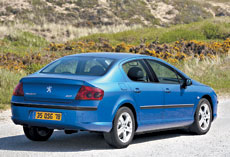 indicators used other means.
indicators used other means. There are cars that look just great in the photographs, but in reality pale. With the Peugeot 407, the opposite is true: it is extremely nephotogenic, but it looks very expressive in life. A makeup was applied to it, already tried on the 206th and 307th, but skillfully changed taking into account the fact that it is still a middle-class sedan, and not a compact hatchback (otherwise some manufacturers love when all their cars, from The class of mini and almost to the representative, are similar to each other as drops of water and differ only in size). But what about the 407th? Satisfied, smiles. Moreover, the smile is equally sincere at the sedan and the S/W station wagon, and the compartment (by the way, drawn by the French themselves, unlike 406 Coupe, created by the Italian studio Pininfarina).
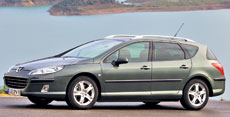 Rust? What are you! It is inconvenient to speak about such things in relation to the car that appeared in 2004. The only thing that should be borne in mind to future owners of the 407th: comments on multiplex wiring of other modern Peugeot are fair in relation to this car. Namely: she painfully reacts to the bushy installed additional equipment, a complex electrician as a result of such an intervention can work with interruptions. It should be noted that the 407th is equipped with a new generation immobilizer, which makes the machine practically uncouraged.
Rust? What are you! It is inconvenient to speak about such things in relation to the car that appeared in 2004. The only thing that should be borne in mind to future owners of the 407th: comments on multiplex wiring of other modern Peugeot are fair in relation to this car. Namely: she painfully reacts to the bushy installed additional equipment, a complex electrician as a result of such an intervention can work with interruptions. It should be noted that the 407th is equipped with a new generation immobilizer, which makes the machine practically uncouraged. The salon of the 407th is very pleasant: the car is richly equipped in the database, it has good sound insulation and decent quality
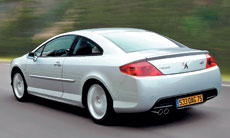 assemblies (although the Japanese are still better). The only more or less serious complaint, the central console is strongly overloaded with small buttons. The car service specialists recommend monitoring the state of the air filter: for the normal functioning of the ventilation system, it should always be clean. The unusual body design, reminiscent of Cab-Forward from Chrysler, provided a lot of space in front and back, as well as a spacious trunk (especially with the station wagon: the maximum volume of the cargo compartment can be brought to 1.7 cubic meters). But not only the architecture of the body helped to make the interior spacious: the compact design of the rear multi -link suspension made it possible to increase the space for the rear passengers and baggage (by the way, inclined shock absorbers connecting the lower levers not with the body, but with the grinder, seriously reduced the level of vibrations in the cabin).
assemblies (although the Japanese are still better). The only more or less serious complaint, the central console is strongly overloaded with small buttons. The car service specialists recommend monitoring the state of the air filter: for the normal functioning of the ventilation system, it should always be clean. The unusual body design, reminiscent of Cab-Forward from Chrysler, provided a lot of space in front and back, as well as a spacious trunk (especially with the station wagon: the maximum volume of the cargo compartment can be brought to 1.7 cubic meters). But not only the architecture of the body helped to make the interior spacious: the compact design of the rear multi -link suspension made it possible to increase the space for the rear passengers and baggage (by the way, inclined shock absorbers connecting the lower levers not with the body, but with the grinder, seriously reduced the level of vibrations in the cabin). 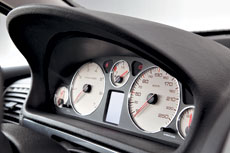 The suspension of the 407th generally has the same advantages: the front two-winging scheme (usually used in rear-wheel drive cars, but in this case adapted for the front-wheel drive), coupled with the rear multi-link helped to achieve excellent controllability, high stability in direct and unexpected comfort (rolls and grafting are reduced to minimum). However, in relation to the Peugeot car, such praises are unlikely to surprise anyone: the French have long learned how to perfectly tune the pendants. But the motors do not shine: the version with a 1.8 liter engine does not go, other modifications tell the car only sufficient dynamics (in fact, who will now surprise 210-horsepower V6, when the same Opel Vectra has 280- Strong turbo engine?).
The suspension of the 407th generally has the same advantages: the front two-winging scheme (usually used in rear-wheel drive cars, but in this case adapted for the front-wheel drive), coupled with the rear multi-link helped to achieve excellent controllability, high stability in direct and unexpected comfort (rolls and grafting are reduced to minimum). However, in relation to the Peugeot car, such praises are unlikely to surprise anyone: the French have long learned how to perfectly tune the pendants. But the motors do not shine: the version with a 1.8 liter engine does not go, other modifications tell the car only sufficient dynamics (in fact, who will now surprise 210-horsepower V6, when the same Opel Vectra has 280- Strong turbo engine?). The gamma of the engines includes four main gasoline: EW7 (1.8 liters, 120 hp), EW10 (2 l, 140 hp; there is a version of EW10A with variable phases of gas distribution), EW12 (2.2 l 160 hp) and top 210-horsepower three-liter V6 ES9. By
 compared to the engines of the 406th, the 407th power units are not so capricious (probably also a small age of the model), but they are sensitive to unprofessional maintenance. They love high -quality engine oil very much and do not take over it (it would be nice to make it a rule to the annual cleaning of the radiator from dirt, salt and fluff in modern engines with a tense thermal mode). Timely conduct is important no less than the use of original spare parts and lubricants: dealers are recommended once every 20 thousand km to change oil (although some believe that 20 thousand for Russia in general and for Moscow in particular is a bit too much, and advise to change the oil two times every two times More often), and every 60 thousand km fuel and air filters (although in our conditions a more frequent update may be required).
compared to the engines of the 406th, the 407th power units are not so capricious (probably also a small age of the model), but they are sensitive to unprofessional maintenance. They love high -quality engine oil very much and do not take over it (it would be nice to make it a rule to the annual cleaning of the radiator from dirt, salt and fluff in modern engines with a tense thermal mode). Timely conduct is important no less than the use of original spare parts and lubricants: dealers are recommended once every 20 thousand km to change oil (although some believe that 20 thousand for Russia in general and for Moscow in particular is a bit too much, and advise to change the oil two times every two times More often), and every 60 thousand km fuel and air filters (although in our conditions a more frequent update may be required). A rare case: the 407th already has four gearboxes! One mechanical (by the way, the basic version of a machine with a 1.8 liter engine
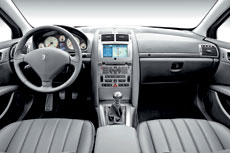 available only with it), the remaining three automatic. With a 2.2 liter engine, the reliable German box ZF is joined, with a top three -liter V6 AISIN machine (there are no problems with it). But a car with a two -liter engine is equipped with a box of its own development. At the Peugeot 406 and 206, she did not show itself very well: some machines had malfunctions in the work of solenoids, the butter was burned more likely not even in an unsuccessful design, but that this box reacts more painfully to bullying than Japanese and German gearboxes. If you monitor the French unit, do not overheat the oil and do not violate the operating rules, then it will work for conscience.
available only with it), the remaining three automatic. With a 2.2 liter engine, the reliable German box ZF is joined, with a top three -liter V6 AISIN machine (there are no problems with it). But a car with a two -liter engine is equipped with a box of its own development. At the Peugeot 406 and 206, she did not show itself very well: some machines had malfunctions in the work of solenoids, the butter was burned more likely not even in an unsuccessful design, but that this box reacts more painfully to bullying than Japanese and German gearboxes. If you monitor the French unit, do not overheat the oil and do not violate the operating rules, then it will work for conscience. An additional advantage of the advanced suspension design Durability of parts. Applying a double -leaf front suspension, the designers have achieved that the load on the front shock absorbers does not change depending on the corner
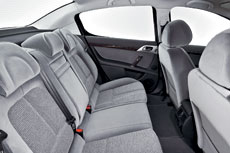 the rotation of the steering wheel, and this could not but affect their service life (100 thousand km they will pass without any problems). Otherwise, the chassis is as strong as that of the previous 406th, the suspension of which is highly reliable: stabilizers racks go at least 60 thousand, steering rods are more than 50 thousand km. Brakes (disk at all corners) serve for quite some time almost regardless of the driving style (of course, if we are talking about a driver who is all right with his head): 20-30 thousand km front pads, 40-60 thousand rear. There are enough discs for two or three sets of linings.
the rotation of the steering wheel, and this could not but affect their service life (100 thousand km they will pass without any problems). Otherwise, the chassis is as strong as that of the previous 406th, the suspension of which is highly reliable: stabilizers racks go at least 60 thousand, steering rods are more than 50 thousand km. Brakes (disk at all corners) serve for quite some time almost regardless of the driving style (of course, if we are talking about a driver who is all right with his head): 20-30 thousand km front pads, 40-60 thousand rear. There are enough discs for two or three sets of linings. In general, the revolutionary changes in the appearance of the Peugeot 407 were in the very suit: the car became more solid, modern and more perfect. At the same time, it was possible not to lose the positive qualities of the predecessor and even add a little in reliability (although it is difficult to judge the car far from far from being far from being old). Nevertheless, it is time to reinforce changes in the image with radical changes in technical filling. Here they would make a 270-300-horsepower Peugeot 407 Coupe eh!
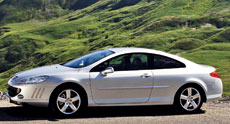 The advantages and disadvantages of the model
The advantages and disadvantages of the model Advantages
Excellent handling
The smoothness of the course
Successful suspension design
Recognizable appearance
High level of security
Flaws
Dear body spare parts
Pale motor gamut
High price of used cars
There are problems with the electrician
Long front overhang
Video test drives Peugeot 406 1999 - 2004
PEUGEOT 406 1999 test drives - 2004
PEUGEOT 406 1999 - 2004 Krash Test
Krassh Test: Detailed Information18%
Driver and passengers
14%
Pedestrians
PEUGEOT 406 1999 - 2004
PEUGEOT 406 malfunctions: Detailed information| 406 1999 - 2004 | |
|---|---|
| Engine |  |
| Transmission |  |
| Control system and suspension |  |
| Brake system |  |
| Air heating and air conditioning |  |
| Launch and charging system |  |
| Electric components and so on |  |
| Corrosion body stability |




